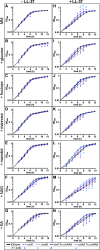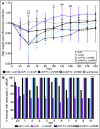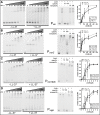The C. difficile clnRAB operon initiates adaptations to the host environment in response to LL-37
- PMID: 30125334
- PMCID: PMC6117091
- DOI: 10.1371/journal.ppat.1007153
The C. difficile clnRAB operon initiates adaptations to the host environment in response to LL-37
Abstract
To cause disease, Clostridioides (Clostridium) difficile must resist killing by innate immune effectors in the intestine, including the host antimicrobial peptide, cathelicidin (LL-37). The mechanisms that enable C. difficile to adapt to the intestine in the presence of antimicrobial peptides are unknown. Expression analyses revealed an operon, CD630_16170-CD630_16190 (clnRAB), which is highly induced by LL-37 and is not expressed in response to other cell-surface active antimicrobials. This operon encodes a predicted transcriptional regulator (ClnR) and an ABC transporter system (ClnAB), all of which are required for function. Analyses of a clnR mutant indicate that ClnR is a pleiotropic regulator that directly binds to LL-37 and controls expression of numerous genes, including many involved in metabolism, cellular transport, signaling, gene regulation, and pathogenesis. The data suggest that ClnRAB is a novel regulatory mechanism that senses LL-37 as a host signal and regulates gene expression to adapt to the host intestinal environment during infection.
Conflict of interest statement
The authors have declared that no competing interests exist.
Figures









Similar articles
-
Glycine fermentation by C. difficile promotes virulence and spore formation, and is induced by host cathelicidin.Infect Immun. 2023 Oct 17;91(10):e0031923. doi: 10.1128/iai.00319-23. Epub 2023 Sep 27. Infect Immun. 2023. PMID: 37754683 Free PMC article.
-
IL-27 induces LL-37/CRAMP expression from intestinal epithelial cells: implications for immunotherapy of Clostridioides difficile infection.Gut Microbes. 2021 Jan-Dec;13(1):1968258. doi: 10.1080/19490976.2021.1968258. Gut Microbes. 2021. PMID: 34432564 Free PMC article.
-
Clostridioides difficile Modifies its Aromatic Compound Metabolism in Response to Amidochelocardin-Induced Membrane Stress.mSphere. 2022 Oct 26;7(5):e0030222. doi: 10.1128/msphere.00302-22. Epub 2022 Aug 22. mSphere. 2022. PMID: 35993700 Free PMC article.
-
The human cathelicidin LL-37: a multifunctional peptide involved in infection and inflammation in the lung.Pulm Pharmacol Ther. 2005;18(5):321-7. doi: 10.1016/j.pupt.2005.01.001. Pulm Pharmacol Ther. 2005. PMID: 15939310 Review.
-
Host recognition of Clostridium difficile and the innate immune response.Anaerobe. 2014 Dec;30:205-9. doi: 10.1016/j.anaerobe.2014.08.014. Epub 2014 Sep 16. Anaerobe. 2014. PMID: 25223264 Free PMC article. Review.
Cited by
-
The Potential of Human Peptide LL-37 as an Antimicrobial and Anti-Biofilm Agent.Antibiotics (Basel). 2021 May 29;10(6):650. doi: 10.3390/antibiotics10060650. Antibiotics (Basel). 2021. PMID: 34072318 Free PMC article. Review.
-
Regulation and Anaerobic Function of the Clostridioides difficile β-Lactamase.Antimicrob Agents Chemother. 2019 Dec 20;64(1):e01496-19. doi: 10.1128/AAC.01496-19. Print 2019 Dec 20. Antimicrob Agents Chemother. 2019. PMID: 31611350 Free PMC article.
-
Myxopyronin B inhibits growth of a Fidaxomicin-resistant Clostridioides difficile isolate and interferes with toxin synthesis.Gut Pathog. 2022 Jan 6;14(1):4. doi: 10.1186/s13099-021-00475-9. Gut Pathog. 2022. PMID: 34991700 Free PMC article.
-
c-di-AMP signaling is required for bile salt resistance, osmotolerance, and long-term host colonization by Clostridioides difficile.Sci Signal. 2022 Sep 6;15(750):eabn8171. doi: 10.1126/scisignal.abn8171. Epub 2022 Sep 6. Sci Signal. 2022. PMID: 36067333 Free PMC article.
-
Glycine fermentation by C. difficile promotes virulence and spore formation, and is induced by host cathelicidin.Infect Immun. 2023 Oct 17;91(10):e0031923. doi: 10.1128/iai.00319-23. Epub 2023 Sep 27. Infect Immun. 2023. PMID: 37754683 Free PMC article.
References
Publication types
MeSH terms
Substances
Grants and funding
LinkOut - more resources
Full Text Sources
Other Literature Sources

